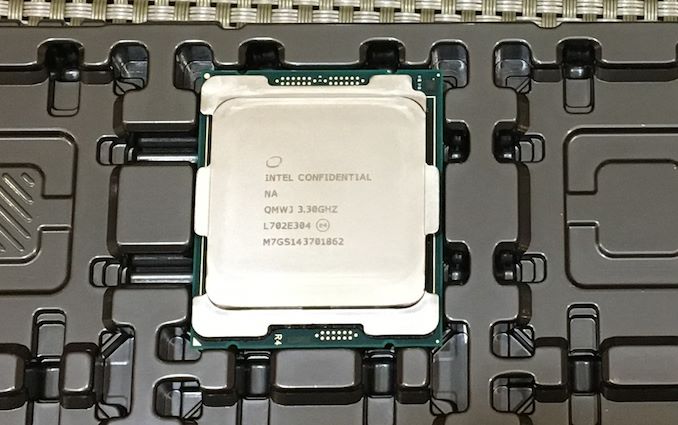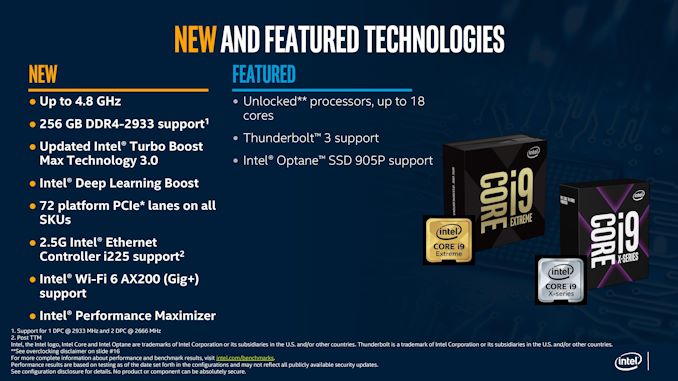Intel's Cascade Lake-X CPU for High-End Desktops: 18 cores for Under $1000
by Dr. Ian Cutress on October 1, 2019 6:35 PM EST- Posted in
- CPUs
- Intel
- HEDT
- LGA2066
- Cascade Lake

With someone in the press having broken their embargo earlier today, Intel is lifting the lid earlier than planned on their upcoming Cascade Lake-X family of processors for the high-end desktop (HEDT) market. Similar to the way Intel's Cascade Lake based Xeon Scalable processors are a further revision of their Skylake Xeons, offering clock speed increases and security fixes in hardware, the new HEDT processors will grant higher frequencies, more memory capacity, and better protection against side-channel attacks. The key numbers however are the big drop in Intel's pricing: Intel will be releasing its 18-core part, the Core i9-10980XE, for under $1000.
| Intel Cascade Lake-X | |||||||
| AnandTech | Cores Threads |
Base | All Core |
TB2 | TB3 | TDP | Price (1ku) |
| Core i9-10980XE | 18C / 36T | 3.0 | 3.8 | 4.6 | 4.8 | 165 W | $979 |
| Core i9-10940X | 14C / 28T | 3.3 | 4.1 | 4.6 | 4.8 | 165 W | $784 |
| Core i9-10920X | 12C / 24T | 3.5 | 4.3 | 4.6 | 4.8 | 165 W | $689 |
| Core i9-10900X | 10C / 20T | 3.7 | 4.3 | 4.5 | 4.7 | 165 W | $590 |
| Skylake-X (previous generation) | |||||||
| Core i9-9980XE | 18C / 36T | 3.0 | 4.5 | 4.7 | 165 W | $1979 | |
| Core i9-9940X | 14C / 28C | 3.3 | 4.5 | 165 W | $1387 | ||
| Core i9-9920X | 12C / 24T | 3.5 | 4.5 | 165 W | $1189 | ||
| Core i9-9900X | 10C / 20T | 3.5 | 4.5 | 165 W | $989 | ||
This pricing is a significant shift in Intel's strategy, and a number of fingers will be pointed at AMD as having made this happen. Next month AMD is set to launch its 16-core Ryzen 9 3950X at $749, which will offer 16 PCIe 4.0 lanes for slots (+4 for M.2, +4 for chipset) and support for 128 GB of DRAM. So Intel needed something similarly speedy, but with more PCIe lanes and more memory support that they could offer for just a bit more, leading to the 10980XE for $979. Ultimately, the on-shelf price is often just slightly higher than tray price, so don't be surprised if retail prices land at around $1000.
All the CPUs will support 256 GB of quad-channel memory (up from 128 GB), and have 48 PCIe 3.0 lanes (up from 44). Memory speed support is listed as DDR4-2933 for 1 DIMM per channel, and DDR4-2666 for 2 DIMMs per channel. All these CPUs have a TDP of 165 W, which Intel states will help the CPUs to turbo longer under Intel's recommended settings (as we know, consumer motherboard manufacturers like to ignore these anyway). All these CPUs are supported in X299 motherboards.
There is no 16-core in this stack, with Intel's official reasoning being that they assess the market with each generation and they don't believe there's a suitable price point for such a part when the 14C and 18C parts are so close. Most people will point the finger and say that no-16 core Intel part means no direct comparison with the Ryzen 9 3950X, which is something to think about.
Another point to note is that Intel has stopped this stack at the 10 core and no lower. This means that there will be no cross over between Intel's consumer processor stack and the HEDT stack, with users needing to spend just a little bit more from the Core i9-9900K/KF to reach up to the Core i9-10900X. It will be interesting to see where Intel's Core i9-9900KS fits in, although that still only has dual channel memory and 16 PCIe 3.0 lanes.
Intel lists Wi-Fi 6 and 2.5GbE support on these new processors - to clarify, Intel means external controllers here. For some odd reason when Intel says support, it could mean internal to the chipset or external via a controller; this is messaging I've railed against for a while, as it ends up confusing for enthusiasts, especially when this is an enthusiast platform. It does mean however that we get official information about Intel's 2.5GbE controllers, which we've been waiting on for a couple of years. Intel stated that these controllers will be ready at a later date, and more information to follow. (The controllers are currently listed on Intel's ARK database, but as 1 GbE controllers for some reason.)
These CPUs will have the same security mitigations as the Cascade Lake Xeon processors, with updated hardware mitigations for a number of side channel attacks. We are waiting to hear from Intel if the firmware that supports these processors will also have additional fixes in for Zombieload by default.
One question about this launch is surrounding Intel’s 14nm capacity. Within the last week, there have been reports that despite Intel’s best efforts and promises to match demand, and that Q3 and upcoming for Q4 is going to be busier than expected. We reached out to Intel last week for clarification, and the company said that the bulk of its capacity is focusing on the high-end processors in the market: the Xeon Scalable, the Core i9, Core i7, and Core i5. It will be interesting to see if launching another family of products is going to put additional strain on Intel’s capacity and demand.
With AMD's recent Zen 2 Ryzen 3000 series launch on 7nm earlier in the year, Threadripper 3 coming later this year, and Intel swinging another generation of 14++ into the high-end desktop market, Intel is going to have some tough times. Don't get me wrong, this pricing update from Intel is a good thing for users, especially those looking at implementing things like DL Boost to their workflow, but this market is suddenly turning very aggressive, and it will be interesting to see if Intel can be agile enough to keep pace.
Intel's Cascade Lake-X processors will be available in November. More details should be released nearer to launch.











162 Comments
View All Comments
twtech - Tuesday, October 1, 2019 - link
This is more or less what I thought we were going to see when Intel was claiming a 2.09x cost efficiency improvement in this class of processors vs. the prior generation.Drumsticks - Tuesday, October 1, 2019 - link
18 cores at $979 feels like the best product in that stack. A $800 14C versus the $750 16C Ryzen seems like a difficult matchup, maybe held up by a slight frequency advantage, but a 10C at $600 doesn't seem like it will hold up very well against a 12C $500 Ryzen 9. Threadripper is going to give AMD some seriously impressive pricing power.BillyONeal - Tuesday, October 1, 2019 - link
There are still a number of features Intel has (like vTune and AVX512).milkywayer - Tuesday, October 1, 2019 - link
Bravo AMD for the continuous kicking in Intel's rear. The 10 core cpu now is down to $600 from $990. Now that's some fruitful competition.plonk420 - Wednesday, October 2, 2019 - link
sure Intel has a single thread advantage, but i've been enjoying my $450 16 core Threadripper 1950X since last feb when i accidentally won an auction for the board at ~$190Flunk - Wednesday, October 2, 2019 - link
They did... not so much anymore.emn13 - Friday, October 4, 2019 - link
That single-thread advantage may play out differently here; traditionally intel HEDT chips haven't been nearly as great as their plain old desktop K processors in practice; but there are features this time around (e.g. turboboost 3.0) that suggest it might be a little better this time. And we have pretty little info on what (zen 2) threadripper will be like; at least not in the kind of details you'd need to really predict stuff like single-core perf.I'd wait and see.
evernessince - Tuesday, October 1, 2019 - link
As far as I know, Intel doesn't have 512 bit AVX registers so it has to do 2 passes for 512 just like AMD does. The difference being, AMD processors don't need an AVX offset like Intel processors do.hansmuff - Tuesday, October 1, 2019 - link
AMD does simply not have any part of AVX-512 implemented. It can't do it at this stage. Intel CPUs implement different parts of AVX-512 at various market segments. There are AVX-512 sets of instructions that make no sense in a consumer CPU. Also the hardware implementation of AVX-512 requires a lot of die space, so it's not even feasible to have all instructions on all chips.But the takeaway here is that no, AMD does not do AVX-512 at all and Intel does it selectively.
kobblestown - Wednesday, October 2, 2019 - link
In their initial implementation of AVX512 intel had two lines of processors - 2 AV512 units for the higher end and a single AVX512 unit for the lower end. In both cases one of the units comes from the fusion of both AVX2 units and there is an additional (or there isn't, depending on model) a dediacted avx512 unit.So for these lower end ones with the single AVX512 unit the situation is identical to how AMD used to do AVX2 with both SSE units. I assume that's what the OP had in mind. However, as far as I can tell, all these Core X processors *do* have two AVX512 units so the only disadvantage will be the lower clocks when they are in use (and lack of software that uses them).
In any case, I think this is something AMD can easily compensate for with higher core count. The rest is up to price.